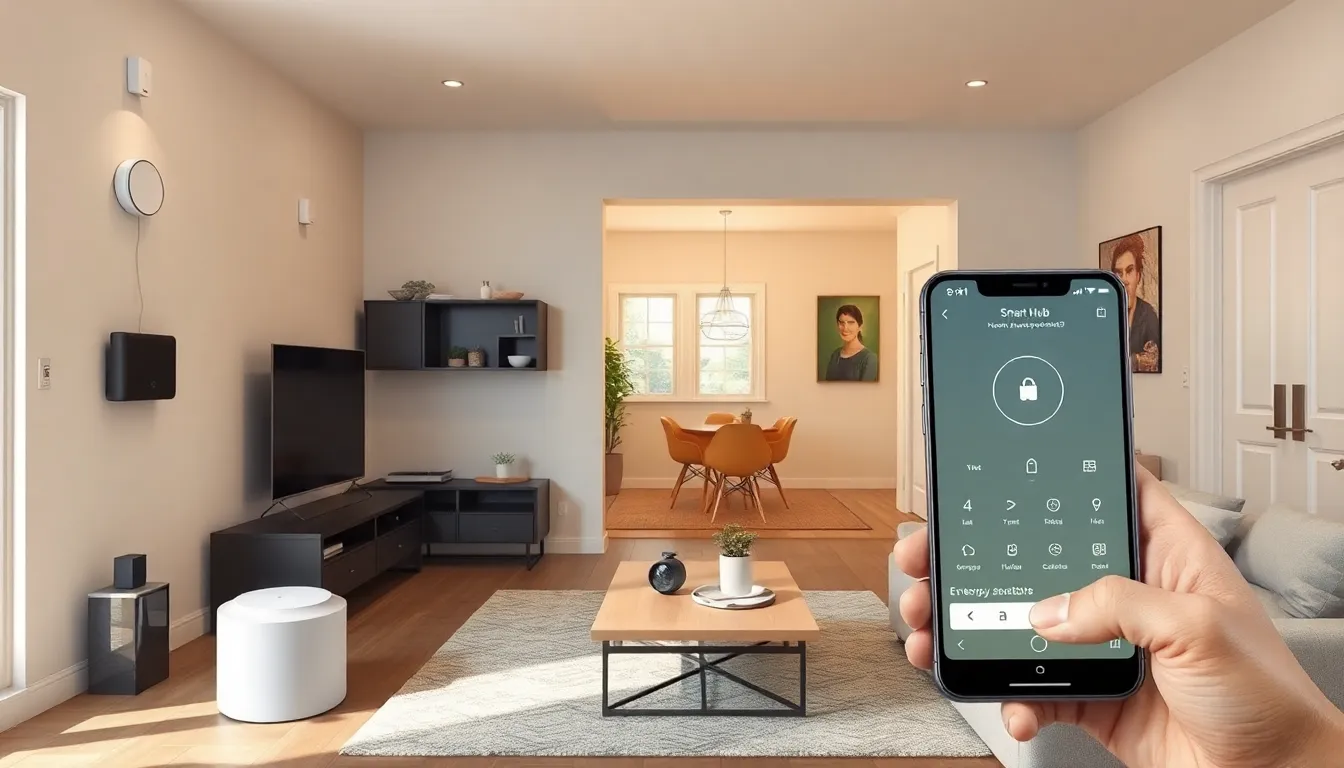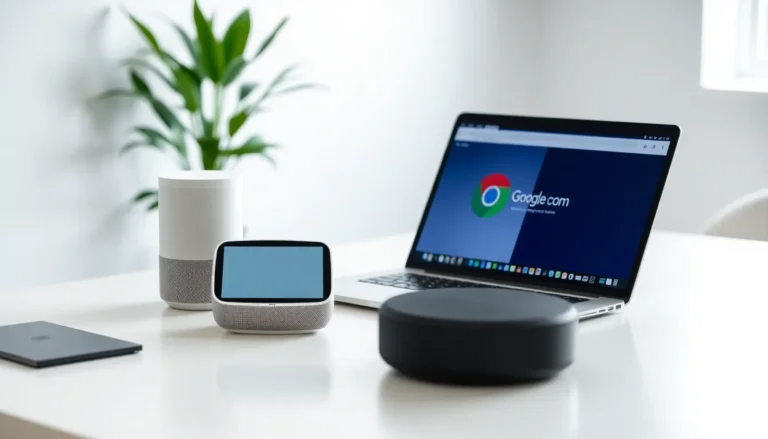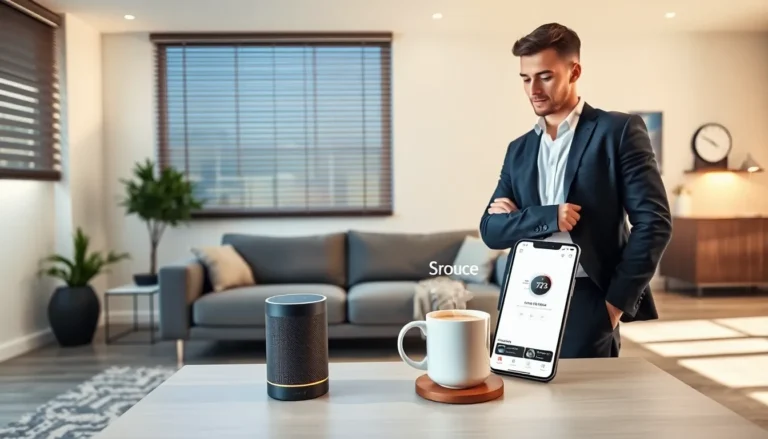Table of Contents
ToggleHome automation systems are transforming the way people interact with their living spaces. With the ability to control everything from lighting to security through a single device, these systems offer convenience and peace of mind. As technology continues to evolve, more homeowners are embracing this innovative approach to streamline their daily routines.
Imagine adjusting your thermostat, locking your doors, and turning off lights—all with a simple voice command or tap on your smartphone. This seamless integration not only enhances comfort but also promotes energy efficiency. As the demand for smart homes grows, understanding the benefits and features of home automation systems becomes essential for anyone looking to upgrade their living environment.
Overview of Home Automation Systems
Home automation systems consist of interconnected devices that enhance the management of residential environments. These systems enable users to automate tasks, ranging from controlling lights and thermostats to managing security cameras and door locks.
Key components of home automation systems include:
- Smart Hubs: Act as the central command unit, allowing various devices to communicate and operate cohesively.
- Sensors: Detect changes in the environment, such as motion, temperature, and light levels, providing data to the system.
- Smart Devices: Include items such as smart bulbs, smart locks, and smart thermostats, which execute commands relayed by the hub.
- User Interfaces: Applications or web interfaces that allow users to control devices remotely, schedule tasks, or receive notifications.
Home automation systems improve energy efficiency by enabling users to reduce energy consumption. For instance, smart thermostats can adjust heating and cooling settings based on user habits, resulting in cost savings. Security features, like automated lighting, enhance safety by simulating occupancy when homeowners are away.
As technology evolves, integration with voice assistants and smart home ecosystems becomes more common, simplifying the user experience. Homeowners opting to invest in automation solutions benefit from increased convenience, security, and energy savings in their daily lives.
Key Components of Home Automation Systems

Home automation systems consist of several key components that work together to enhance the functionality and efficiency of a living space. Understanding these components aids in selecting the right system tailored to individual needs.
Smart Hubs
Smart hubs serve as the central point of control for home automation systems. They connect and communicate with various smart devices, allowing users to manage all components from a single interface. Popular smart hubs include platforms like Samsung SmartThings, Amazon Echo Plus, and Google Nest Hub. Smart hubs provide protocol compatibility, enabling different devices to work seamlessly, regardless of manufacturer. By consolidating device control, smart hubs simplify user interaction and enhance system performance.
Sensors and Devices
Sensors and devices form the backbone of home automation systems. Key types include:
- Motion Sensors: Detect movement within a specified area, triggering alerts or automated actions, such as turning on lights.
- Temperature Sensors: Monitor indoor climate conditions, facilitating communication with smart thermostats to optimize heating and cooling.
- Security Cameras: Provide real-time surveillance and alerts, enhancing home security.
- Smart Locks: Allow for keyless entry, grants temporary access codes, and enable remote locking or unlocking.
These devices contribute to improved energy management and enhanced security within homes, promoting user comfort and peace of mind.
User Interfaces
User interfaces enable interaction with home automation systems. Common types include:
- Mobile Apps: Provide remote access to systems, allowing users to control devices from smartphones or tablets.
- Voice Assistants: Enable hands-free control through platforms like Amazon Alexa, Google Assistant, or Apple Siri.
- Touchscreen Panels: Centralize control within the home, offering easy navigation for managing devices and settings.
Effective user interfaces enhance accessibility and user experience, making home automation intuitive and straightforward.
Benefits of Home Automation Systems
Home automation systems provide numerous advantages for modern households. They enhance daily living through convenience, efficiency, and security.
Convenience and Comfort
Home automation systems streamline daily tasks. Users can control lighting, climate, and appliances remotely, making life easier. Scheduling routines ensures that lights turn on or off at specific times, providing additional comfort. Voice-activated assistants further enhance convenience, allowing users to manage their smart home systems hands-free.
Energy Efficiency
Home automation systems significantly improve energy efficiency. Smart thermostats optimize heating and cooling based on occupancy and user preferences, leading to reduced energy consumption. Automated lighting systems adjust brightness and usage based on natural daylight, minimizing electricity costs. Remote monitoring allows users to identify energy usage patterns and make informed decisions to further decrease energy waste.
Enhanced Security
Home automation systems boost home security with multiple features. Automated lighting simulates occupancy, deterring potential intruders. Security cameras and motion detectors provide real-time monitoring, alerting users of unusual activities. Moreover, smart locks allow remote access control, enabling homeowners to grant entry to visitors without being on-site, enhancing overall safety and peace of mind.
Popular Home Automation Platforms
Home automation platforms play a crucial role in enhancing connectivity and control within smart homes. Several leading systems cater to different user preferences and needs.
Google Home
Google Home integrates seamlessly with various smart devices, providing a versatile automation experience. Using the Google Assistant, users control lighting, thermostats, and security systems through voice commands or the Google Home app. Compatibility extends to numerous third-party devices, offering flexibility in creating a customized smart home ecosystem. Google offers features like routines, which allow users to automate multiple tasks with a single command, adding convenience to daily routines.
Amazon Alexa
Amazon Alexa stands out as a highly popular home automation platform due to its extensive compatibility with thousands of smart devices. Users can control their devices using voice commands via Echo speakers or the Alexa app. The platform supports customizable routines, enabling users to schedule device actions based on their preferences. With skills, Alexa can integrate with various services, enhancing home security through smart cameras and locks and improving convenience through device management.
Apple HomeKit
Apple HomeKit offers a secure and user-friendly environment for managing smart home devices. Using the Home app or Siri, users can easily control compatible devices and create automation scenarios. HomeKit emphasizes privacy and security, ensuring that data remains protected. It supports a wide range of devices, including smart lights, thermostats, and cameras. Users can create scenes, which trigger multiple devices simultaneously, enhancing overall home management and efficiency.
Home automation systems are transforming the way individuals experience their living spaces. With the ability to control lighting security and climate through a single interface these systems offer unparalleled convenience and peace of mind. As technology advances the integration of smart devices continues to enhance energy efficiency and security in homes.
The growing popularity of smart homes highlights the importance of understanding the features and benefits of home automation. By adopting these systems homeowners can enjoy improved comfort and streamlined daily routines. Embracing this technology not only elevates living standards but also contributes to a more efficient and secure home environment.







